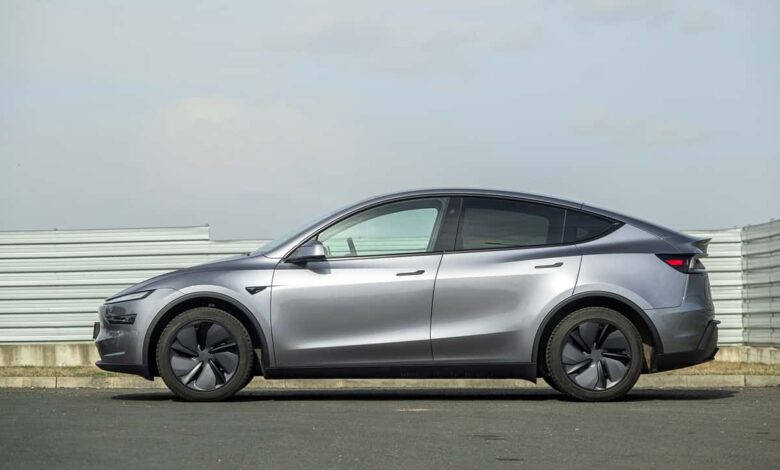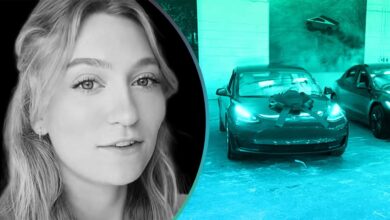Tesla Adds More Range Without Touching The Battery


- Tesla increases the CLTC claimed range of its two most popular models in China without enlarging their batteries.
- The Model 3 LR AWD also gets a $1,400 price hike as a result, while the equivalent Model Y doesn’t.
- This seems like a desperate effort to stop the sales decline, but it’s probably too little, too late.
Tesla has updated the official page for the Model 3 Long Range AWD in China, extending its CLTC range by 25 miles (40 km) without touching the battery. This pushes the CLTC-claimed range to 467 miles (753 km), but it comes bundled with a $1,400 price increase, which bumps this version of the electric sedan to just under $40,000 in China.
The automaker also increased the Model Y LR AWD from 447 miles (719 km) to 471 miles (750 km) without changing the price. It still costs the equivalent of $43,700, just as before. Car News China notes that the expected delivery time for both is very low, just one to three weeks, which is a lot less than the Model Y’s new big rival (that’s also cheaper), the Xiaomi YU7.
Those who have ordered China’s electric Ferrari Purosangue lookalike are expected to wait between 57 and 60 weeks to take delivery. That’s what you get after racking up 200,000 pre-orders in just a few minutes, and you’re still a small automaker that hasn’t yet ramped up the production capacity. However, people are willing to put up with the wait because the YU7 seems to be exactly what the market wants right now.
But the YU7, and the rest of Tesla’s EV competition in China, represent big hurdles for the brand,
Just like in Europe, Tesla sales are slowing in China as the American carmaker (along with all foreign brands) is falling out of favor with Chinese car buyers, who are increasingly choosing from an ever-larger pool of increasingly talented domestic models.
The Xiaomi YU7 and its remarkable popularity set against the backdrop of the Model Y’s downfall in China perfectly illustrate this trend. To further highlight Tesla’s desirability problem in China, its crashing sales come in the context of 35% higher nationwide EV sales in the first quarter of 2025, which is almost exclusively driven by Chinese buyers purchasing from local automakers.
What’s interesting is the reason behind Tesla’s dwindling demand in China. It’s not a direct result of Elon Musk’s foray into politics, his support for Donald Trump, and the bad taste it left in everybody’s mouth. That applies to Europe, the United States, and other Western-leaning markets that follow Western media narratives. In China, buyers aren’t very aware of that and don’t really care.
Tesla is losing ground because it can’t keep up with what the local carmakers are doing and the general EV boom. They are launching models that cater much more to local tastes and preferences, and, on top of that, they offer superior specs in almost every metric, plus they have radar and lidar for extra safety redundancy. Tesla’s image problem in China has nothing to do with how we now perceive the brand in the West.
Sure, a Tesla Model Y is still a great vehicle with decent range and charging specs, and it drives great (it’s arguably more dynamically accomplished than any Chinese rival). However, Tesla’s brand of minimalism no longer resonates with Chinese buyers. Now China has electric sedans that can charge at 1 megawatt, or four times quicker than a Tesla. It’s as if Tesla rested on the laurels of its initial success in the PRC while others were moving the game on, and now it’s fallen too far behind to be able to recover.
Chinese rivals also undercut Tesla on price and generally offer cars with more lavish interiors, featuring the kinds of bells and whistles that local buyers demand, like AI-powered virtual assistants. Just take the BYD Seal electric sedan and the Tesla Model 3, which are direct rivals. The Tesla offers a better driving experience and is more engaging to drive, especially in Performance guise.
But there’s no trace of minimalism (which is nowhere near as big a trend in China as it is in the West, where new-money buyers want lots of features and flash) inside a car from BYD. It looks more conventional inside and out, and it is perceived as the more luxurious of the two, even in Europe, where it’s been on sale since 2024 and is garnering a lot of praise.
I’ve experienced both the Model 3 and the Seal, and I prefer the former in pretty much every metric, but it seems I’m part of a growing minority.
This extra range that Tesla pulled out of thin air seems like a last-ditch effort to get buyers to consider its cars. Tesla could strive to lower prices, but this would hurt its already slim margins in the PRC, which is a market that it dominated a couple of years ago, when it was overtaken by BYD. Its growth started slowing after 2022 and now it’s shrinking, with a sales Q1 downturn of 0.3% year-over-year.
One way Tesla could fix this would be to launch new models, especially ones designed to appeal to Chinese buyers. Even European OEMs are doing it in an attempt to woo Chinese buyers—just look at how the BMW i7 is styled, for instance—and it’s working to a degree.
However, Tesla doesn’t have any new models planned, and it always seems to be a big struggle for the manufacturer to bring a ground-up new model to market. Unlocking a few extra miles of range is not enough to save Tesla in China.
Source link

